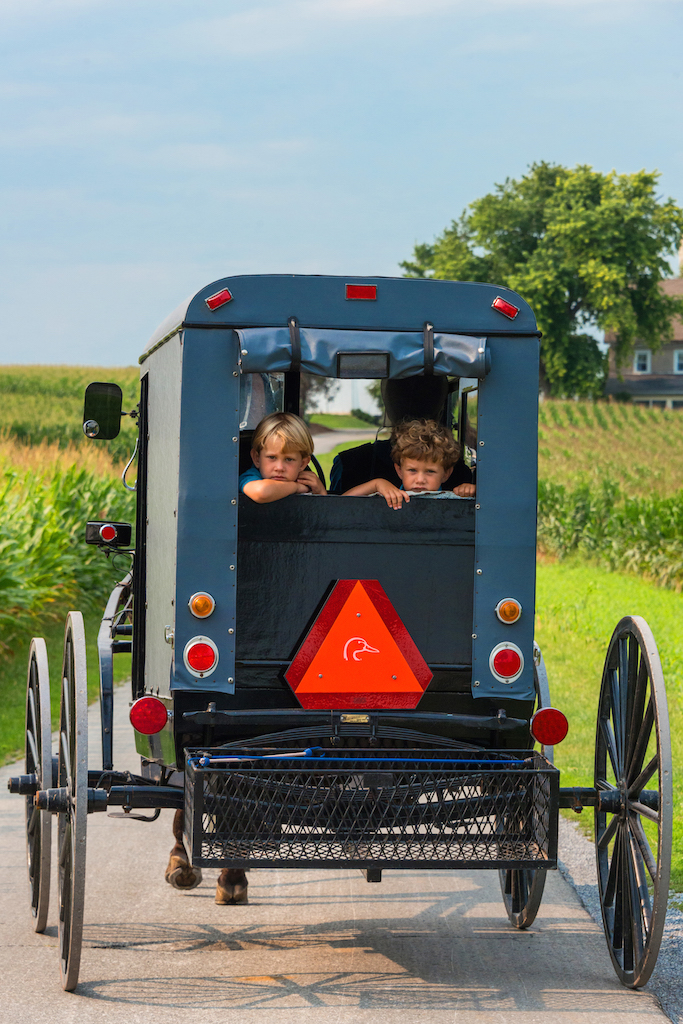An Amish family filed a lawsuit in October 2019 arguing that the removal of the religious exemption to vaccination mandated for school attendance violated their rights under the New York Constitution. The family had three unvaccinated children, who were shut out of a private school that enrolled only 24 students, all of whom were Amish and unvaccinated.1 2 Seeking a preliminary injunction to halt the repeal of the religious exemption so that their children could stay in school pending the outcome of the case. This is the third case requesting a preliminary injunction to halt the implementation of Public Health Law 2164 (“the Law”) since New York took the unprecedented action of passing A2371 that removed the religious exemption in one day without a public hearing.3
On November 4, 2019, Judge Daniel J. Doyle ruled on the preliminary injunction in Seneca County, New York.4
History of the Amish in the U.S
Today, there are more than 150,000 Amish people living in the United States, most of them are descended from families who, 400 years ago, came to America from Europe trying to escape religious persecution and seeking religious freedom. Some Amish and Mennonite groups emigrated to Lancaster, Pennsylvania in response to William Penn’s experiment with establishing a state of religious tolerance.5 6 7
The first Amish settlers arrived in New York in 1831. They were attracted to the area in part because of the protection of free exercise of religion in New York’s Constitution. Currently, about 20,000 members of the Amish religion live a secluded life in farming communities in New York, which is thought to have the fastest growing Amish population in the US. 8 9
Many Amish families hold strong religious beliefs, live in close-knit, self-reliant communities and send their children to Amish-only schools until the 8th grade.10 The U.S. Supreme Court recognized the deeply held religious beliefs of the Amish community when ruled in 1972 that Wisconsin’s compulsory attendance law was unconstitutional under the First Amendment when applied to Amish children past the 8th grade. The Supreme Court held that the State’s interest in compulsory education must yield to the fundamental rights, “protected by the Free Exercise Clause of the First Amendment and the traditional interest of parents with respect to the religious upbringing of their children”11
The Court Ignored Plaintiff’s Religion
In stark contrast to the opinion of the highest U.S. court, which recognized the religious rights of the Amish community, Judge Doyle’s opinion made no mention of the family’s deeply held religious beliefs or their unique lifestyle at an Amish only school in a secluded community, despite the Plaintiff’s Complaint and supporting 47-page Memorandum of Law focusing on their deeply held religious beliefs.12
The Amish put God and community ahead of the individual. The Amish value life as a spiritual activity and believe in separation from, rather than integration with, modern worldly society. The Amish base their daily life and religious practice on a literal interpretation of the Biblical instruction “be not conformed to this world.” (Romans 12:2)….Plaintiff sincerely believes to rely on a man-made vaccination would be an act of unbelief in the power of God to heal and protect. (emphasis added.)13
Recent New York Court Decisions on Public Health Law 2164
In New York, a party seeking a preliminary injunction must show three things by clear and convincing evidence: (1) that they are likely to succeed on the merits or, in other words, win in the end; (2) that they will suffer irreparable harm if the preliminary relief is not granted while waiting for the final judgment; and (3) that the balance of the equities favors their position. In making a determination, the court is required to look at factors such as public policy and hardship to the parties when determining whether granting relief is fair.14
The Plaintiffs contend that the Law, as amended, violates the free exercise clause of the New York State Constitution. This is the second time that plaintiffs have relied exclusively on the New York Constitution rather than the Federal Constitution when challenging the recent changes to this law. In Sullivan-Knapp v. Cuomo, the New York Supreme Court denied a preliminary injunction finding that the Law did not violate the New York Constitution, although it criticized the Legislature for denying children with a religious exemption an education.15 16
In both cases, the plaintiffs assert that New York’s long history supporting religious tolerance and religious liberty is supported by the State Constitution which grants broader rights than the Federal Constitution as evidenced by the inclusion of the words, “forever” and “all humankind”. The New York Constitution Article 1, Section III sets forth,“The free exercise and enjoyment of religious profession and worship, without discrimination or preference, shall forever be allowed in this state to all humankind ” (emphasis added)17
These cases are distinguished from F.F. on behalf of Y.F. v. State, the other lawsuit filed in the 3rd circuit Appellate Court in which plaintiffs were seeking a preliminary injunction asserting the removal of the religious exemption violated the free exercise of religion clause in the United States Constitution and the New York Constitution. In that case, the Appellate Court denied a preliminary injunction and found that, while the plaintiffs would suffer irreparable harm if the preliminary injunction was not granted, they did not establish that they had a likelihood of success on the merits.18
The Court Failed to Balance the Equities
Relying on a 2006 Appellate Court decision, Catholic Charities, the court stated that it would apply a test that balances the interest advanced by the legislation with the individual right to free exercise of religion.19 However, the Court did not appear to apply any balancing test when it determined that Plaintiffs failed to demonstrate a likelihood of success on the merits because they failed to establish that the removal of the religious exemption created an “unreasonable interference to their right to exercise religious freedom”.20
Citing, Mcartney v. Austin, a 1969 Appellate Division case, the Court assumed that there was no need for any discussion at all because Public Health Law 2164, was a valid exercise of state police powers that supercedes the free exercise clause. “..statutes of this nature, and section 2164 in particular, are within the police power and thus constitutional generally is too well established to require discussion.”21
However, the Court failed to consider that when Mcartney was decided, Public Health Law 2164 did include a religious exemption.
The Court also conducted no fact finding, stating;
nothing but a clear violation of the Constitution will justify a court in overruling the legislative will…. Further, the Court is required to apply the “presumption that the Legislature has investigated and found the facts necessary to support the legislation.”(I.L.F.Y Co. v. Temporary State Housing Rent Comm., 10 NY2d 263, 269 [1961] (emphasis added)22
For the Court to assume that the current version of the Law is constitutional simply because it passed the Legislature is a giant leap of faith unsupported by actual facts.23 The Complaint clearly states that no investigation was conducted and included quotes from outraged members of the Legislature including Senator Lanza;
This bill says we don’t even want to hear you. Your beliefs are so foreign to me that I reject them out of hand. You don’t get a hearing, you don’t get a conversation, you get nothing. I believe what I believe, you believe what you believe, and that’s your problem. I think that’s wrong. And it’s a terrible precedent.24
The Court’s Analysis Missed the Mark
The Court’s decision misses the mark as it analyzes whether the Law is constitutional, rather than addressing Plaintiff’s claim that the removal of the religious exemption violates the New York Constitution. This is a distinction of merit. The Plaintiffs do not argue that the Legislature does not have the right to enact laws to protect the health of New Yorkers, rather, they assert that the New York Constitution requires an exemption to be carved out for those whose deeply held religious beliefs conflict with public health law, which is the reason the religious exemption was incorporated into the Law when it was passed in 1963.
This decision contradicts Williams v. Orchard Park Sch. Dist, a New York Supreme Court decided in 2019 that found “New York has long recognized the need to balance the protection of the public health against the constitutional rights of parents to raise their children in accordance to their own religious beliefs” and that Public Health Law 2164 with the religious exemption in tact maintained that balance.25
The Court Ignored the Plaintiff’s Other Arguments
The Court made no mention of the Plaintiff’s claim that denying an education violates the New York Constitution Article XI, Section 1, which established that the Legislature will:
provide for the maintenance and support of a system of free common school, wherein all of the children of this state may be educated.26
The Court also ignored Plaintiff’s assertion that removing the religious exemption, which would result in denying certain children access to an education, effectively amended the New York Constitution without following the Constitutional amendment process as set forth in Article XIX of the New York Constitution. Instead the bill was passed with no debate in the House health committee, no testimony received from health professionals, no input from the public and no fact finding.27
Lessons Learned from New York
The court decisions in New York make it clear that the assault on our constitutional rights and civil liberties will not be remedied in a courtroom.
The sheer number of lawsuits filed by families of children denied an education and the financial toll taken by New York as it repeatedly defends a law that unjustly targets and penalizes a small segment of the population should caution other states considering similar legislation.
References:
1 Associated Press. Upstate NY Amish Family Sues Over End of Religious Vaccine Exemption for School. Syracuse.com Oct. 21, 2019.
2 Stoltzfus v. Cuomo et al., Verified Complaint. First Freedom Oct. 22, 2019.
3 NVIC. New York Bill Removing Religious Vaccine Exemption Turned Into Law on One Day with No Public Hearings. The Vaccine Reaction June 14, 2019.
4 Stoltzfus v. Cuomo. Index No. 2019031. Nov. 4, 2019.
5 First Freedoms. Amish Lawsuit Filed to Restore Religious Liberty in New York. Oct. 22, 2019.
6 Powell A. Amish Origin, Beliefs, and Lifestyle. Trippsavvy Dec. 26, 2018.
7 The Amish in the US and Canada: Before 1900. Religious Tolerance Aug. 12, 2012.
8 Robinson D. NY Vaccinations: What to Know About an Amish Lawsuit seeking to Restore Religious Exemption. Democrat & Chronicle Oct. 21, 2019.
9 Amish America. New York Amish: 55 Settlements & Counting. Nov. 10, 2017.
10 The Life of an Amish Child (part 1). Amish Mennonite Quilts.
11 Wisconsin v. Yoder, 406 U.S. 205 (1972).
12 Stoltzfus v. Cuomo et al. Memorandum Of Law In Support of Preliminary Injunction. Sept.16, 2019.
13 Stoltzfus v. Cuomo et al., Verified Complaint. First Freedom Oct. 22, 2019.
14 4 Broadway LLC v. West Side SRO Law Project, 86 A.D.3d 18 (N.Y. App. Div. 2011).
15 Hendler C. New York Supreme Court Denies Injunction, Criticizes Legislature for New Vaccine Law. NVIC Newsletter Oct.17, 2019.
16 Judge Wiggens who decided Sullivan-Knapp v. Cuomo, No. E2019-1338CV, (S.C. N.Y. Oct. 9, 2019) has since retired from the bench and has been replaced by Judge Doyle who decided this matter.
17 The Constitution of the State of New York. Article 1 Bill of Rights.
18 Ibid.
19 Catholic Charities of Diocese of Albany v. Serio, 7 N.Y.3d 510 (N.Y. 2006).
20 Stoltzfus v. Cuomo et. al Index No. 20190311 Nov. 4, 2019.
21 Ibid citing McCartney v. Austin, 31 AD2d 370, 371 [3d Dept 1969].
22 Ibid.
23 New York State Assembly. A02371 Bill to Repeal Exemption to Vaccination for Religious Beliefs. Bill History Summary of Actions. June 13, 2019.
24 Stoltzfus v. Cuomo et al., Verified Complaint. First Freedom. Oct. 22, 2019.
25 Williams v. Orchard Park Sch. Dist., 801602/2019, (NY Sup. Ct. 2019).
26 The Constitution of the State of New York Article XI, Section 1 Education.
27 Stoltzfus v. Cuomo et al., Verified Complaint. First Freedom Oct. 22, 2019.













11 Responses
I think it’s criminal what the court did to the family referenced in the article. I think Amish people should go back to home-schooling. There’s got to be some Amish in each town that would be able to teach math, science (farming, nutrition), English and other subjects. I’m not Amish and I don’t get vaccinated any longer. I hope it will never be mandatory.
New York is a bad state, I hope I never have to live there. The first amendment says freedom and it is being disregarded as well as other human rights. Government should leave people alone. Too much government interference.
Dictator Cuomo and the minions of the oligarchs in the NY legislature care not for God’s law or even natural law. They think they’re law unto themselves. They’ll be punished either here or in the afterlife.
I am a cautious person when it comes to vaccines and will stand up for anyone who is cautious or even anti-vaccine, except the Amish. I won’t stand up for someone who won’t stand up for me and as they are anti-military but sleep under the freedom of this flag that gives them the right to protest laws, they have no right to say anything.
Your comment is so egregious that I find it hard to accept you actually put it in writing. The Amish came here for religious freedom and it’s not up to you to agree to punish their children. I am flabbergasted that you can be so self-righteous.
Aren’t we all are God’s children here? Can we choose our lifestyle in the most democratic and free country in the world? Life is too short to be angry.
A big thank you to State Senator Lanza. This law is an outrage and infringes on every citizens rights. Vaccine is a not one size fits all. And should be reviewed on a case to case basis. A personal decision too. Exemptions need to exist for those cases of religious philosophical and medical needs. When faced with reactions I was not able to get any medical professional doctor to go up against the powerful CDC in 1995. Therefore after careful consideration and prayer it was clear that protection from vaccine was needed after multiple tries at vaccinating with side effects. With limited options left and no doctor to back me up I claimed my rights to religious belief. Today it seems not an option. My sincere concern goes out to parents of young children faced with the option of no option. Its simply not right to inject harmful agents into ones child if they can not handle it.
If it will help, the next time there is a demonstration against forced vaccination in Albany, I would be glad to sponsor and pay for a bus….or more than one, brining Amish people to Albany to join in our protest against the corruption and denial of democracy by the New York Governor and legislators. Governor Cuomo received $48 million from pharmaceutical companies, other legislators also received payoffs, for their support of the unconstitutional law denying the right of free and informed medical choice.
The Amish only educate until the 8th grade. This is easily done at home and I’m sure they can do it. It will be better anyway as it will be in line with their values. I no longer look to the justice system for justice. I no longer look to the law for protection. Instead, I look to avoid and survive and stealthily fight where I can, but we are woefully outnumbered. If you’ve been paying attention to what’s going on in Maine (where I live) you will know what I am talking about. The saddest day for us was the defeat of the vaccine referendum by 2/3 of the population. We have a 10 year old who to this day has severe expressive language disorder. Sadly minutes before his shot at age one he demonstrated a 30 word vocabulary. The next day he stopped talking for two full years. It’s going to be a long 8 years for us to avoid him getting shots. Every day we live on God’s grace. I hope we can all make it until the world regains its sanity.
Well, who’d want a NY State education in the first place ? Real education – schooling, teaching – is a right and responsibility of parents/family ! The WORST place, the WORST entity in which to place any educational provision is in the hands of government ! ANY level of government ! Very local control, that is, a system that is directly controlled by parents, is the only acceptable one and that must be carefully and constantly protected from any government entity that can exert ‘muscle’ over the choices of parents and their chosen avenues of educating their children .
I, myself, am a New Yorker – born and raised in Queens, Long Island and did receive an excellent education. It was in private – parochial schools and it was a good many years ago. But I did attend, very briefly, a public school and in those years, it was a most excellent way to learn. Almost all schools at that time, and earlier, taught by the ‘Classical Method” which remains the very best method for instructing children – from their earliest years on through higher learning.
like many other things..vaccines are for making money..and secondary use as population control.. seeing that vaccines not only kill but maim it causes stress and undo medical procedures as well as creating an unwillingness for all medical procedures.. this is a dangerous precedence for all free born peoples.